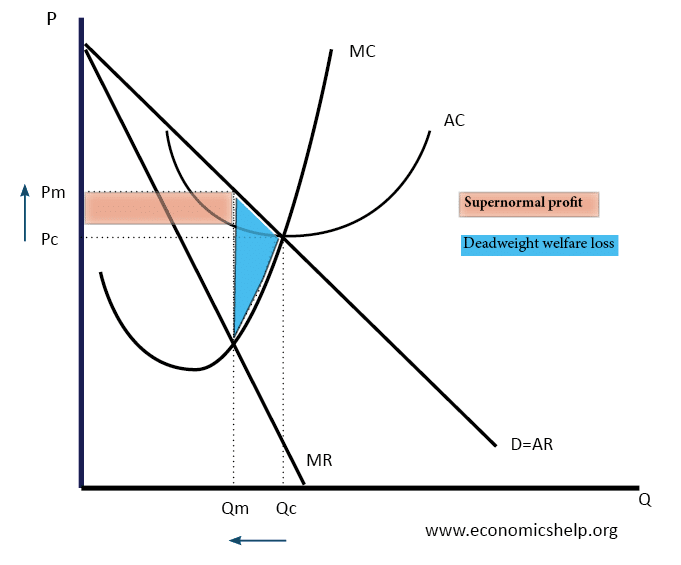
Ch 12 - Market power: Monopoly and oligopoly
Revenue and cost curves in a monopolistic competition:
Each firm is able to differentiate to some degree, it can reduce its price and increase its net revenues
The demand curve for this market will tend to have a sloping downward demand curve
Monopoly: the exclusive possession or control of the supply of or trade in a commodity or service.
Characteristic of demand curve of the monopolistic competitive firm:
Market faces a relatively elastic demand
For every addition output to be sold, the firm will need to sell its output at a lower price
Short run and long run profits of MC firms:
Economic profits made in short run attract new firms to enter the market
Demand for goods reduced as competition increases
Firms are more likely to make a profit since they maximise their profits at a level where MR=MC
Profit is equal to average total cost
Firms in the market can easily make losses due to reducing demand

A firm’s monopolistic market cannot achieve both productive efficiency and allocative efficiency (produces at a point where MC curve cuts the AR curve). Despite firms in this type of market being profit maximisers, in the long run, they are neither allocative efficient nor productive efficient.
Oligopoly: market with few dominant sellers which together controls all or most of a market share.
Interdependence of firms: action of one firm affects the action of the other firms
Barriers to entry: market maintains its small number
Non price competition
Formal Collusion: exists when firms form an organisation or a group which prices the amount of output to be produced is decided
Tacit Collusion: type of collusion that exists when firms charge the same price on goods they produce without having a formal agreement
Market efficiency in Oligopoly:
Produces where marginal revenue is equal to marginal cost MR=MC
Non-collusive oligopoly:
exists when firms in the market do not organise themselves to decide on the price and the quantity of outputs to be produced
Disadvantages of monopoly:
Higher prices Higher price and lower output than under perfect competition. This leads to a decline in consumer surplus and a deadweight welfare loss
Allocative inefficiency. A monopoly is allocatively inefficient because in monopoly the price is greater than MC. P > MC. In a competitive market, the price would be lower and more consumers would benefit
Diseconomies of scale – It is possible that if a monopoly gets too big, it may experience diseconomies of scale. – higher average costs because it gets too big
Advantages of monopoly:
Research and development: The supernormal profit can enable more investment in research and development, leading to better products.
Good quality firm: A firm may gain monopoly power because it is very innovative and successful, e.g. Google, Amazon, Apple. Therefore, monopoly does not always lead to inefficiency.
Ch 12 - Market power: Monopoly and oligopoly
Revenue and cost curves in a monopolistic competition:
Each firm is able to differentiate to some degree, it can reduce its price and increase its net revenues
The demand curve for this market will tend to have a sloping downward demand curve
Monopoly: the exclusive possession or control of the supply of or trade in a commodity or service.
Characteristic of demand curve of the monopolistic competitive firm:
Market faces a relatively elastic demand
For every addition output to be sold, the firm will need to sell its output at a lower price
Short run and long run profits of MC firms:
Economic profits made in short run attract new firms to enter the market
Demand for goods reduced as competition increases
Firms are more likely to make a profit since they maximise their profits at a level where MR=MC
Profit is equal to average total cost
Firms in the market can easily make losses due to reducing demand

A firm’s monopolistic market cannot achieve both productive efficiency and allocative efficiency (produces at a point where MC curve cuts the AR curve). Despite firms in this type of market being profit maximisers, in the long run, they are neither allocative efficient nor productive efficient.
Oligopoly: market with few dominant sellers which together controls all or most of a market share.
Interdependence of firms: action of one firm affects the action of the other firms
Barriers to entry: market maintains its small number
Non price competition
Formal Collusion: exists when firms form an organisation or a group which prices the amount of output to be produced is decided
Tacit Collusion: type of collusion that exists when firms charge the same price on goods they produce without having a formal agreement
Market efficiency in Oligopoly:
Produces where marginal revenue is equal to marginal cost MR=MC
Non-collusive oligopoly:
exists when firms in the market do not organise themselves to decide on the price and the quantity of outputs to be produced
Disadvantages of monopoly:
Higher prices Higher price and lower output than under perfect competition. This leads to a decline in consumer surplus and a deadweight welfare loss
Allocative inefficiency. A monopoly is allocatively inefficient because in monopoly the price is greater than MC. P > MC. In a competitive market, the price would be lower and more consumers would benefit
Diseconomies of scale – It is possible that if a monopoly gets too big, it may experience diseconomies of scale. – higher average costs because it gets too big
Advantages of monopoly:
Research and development: The supernormal profit can enable more investment in research and development, leading to better products.
Good quality firm: A firm may gain monopoly power because it is very innovative and successful, e.g. Google, Amazon, Apple. Therefore, monopoly does not always lead to inefficiency.
 Knowt
Knowt
